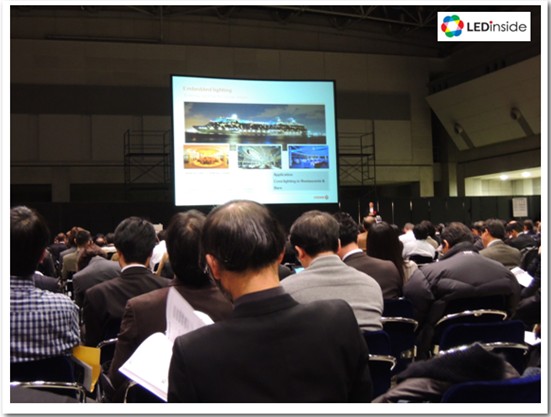Osram officially spin-off from parent firm Siemens AG of Germany in July 2013, becoming an independent firm in order to fully provide for their clients. Lighting Japan 2014 invited Osram to give a keynote speech in their smart lighting conference to elaborate on the changing trends in the LED industry. During the conference, Osram mentioned having a complete supply chain including chip, package, module, lamp, solution, and after sales services in order to fully develop the LED lighting market. How to use the advantages of LED products and technology to develop energy management systems is consistently a deeply discussed topic.
 |
Attendees listen intently to the keynote speech by Osram at Lighting Japan 2014. (LEDinside)
|
When speaking about the initial development of the LED industry, Osram mentioned that the topic of how to increase LED luminosity is hotly discussed. The hope is to increase luminosity from the current 50lm/W up to 100lm/W. From 2012 till now, products have constantly been chasing superiority in price/performance ratio in order to meet market demands. Lowering costs has become the main target for manufacturers. Therefore, unlike lighting fixtures with life spans of 5-10 years, LED specifications must be upgraded every year in order to meet market demand. Embedded lighting and controllable lighting is the key to future development in the lighting business.
In regards to embedded lighting, Osram proposed the LED market should turn to niche markets including automotive LED, IR LED, and LED displays, as well as comfortable lighting designs concepts, and lastly creating artificial planar lighting sources. The above listed will allow LED luminaire manufacturers to think whether luminaires need to keep a fixed form.
For LED controllable lights, Osram talked about energy management systems. Using a smart management interface to integrate LED and energy management ECG can utilize the superiority of LEDs. The DALI system combines lighting, space, and sensors to monopolize household energy management market share. More and more lighting management solutions are now being launched, such as the Encelium GreenBuss II which is a smart lighting control management system that can be used in industrial lighting, office lighting, and architectural lighting.
Energy management systems can currently be used for these four applications:
1. Energy Consumption Management: Energy consumption will be recorded in the information database through the management interface. This allows users, such as manufacturers, to reach their energy saving targets.
2. Remote Control: Users can familiarize themselves with the fixtures life span and set a periodic maintenance plan through the interface.
3. Individual Lighting Management: User can manage brightness, and adjust light intensity and color to suit their individual needs.
4. Area Analysis: Light management resources can be recorded and initiate analysis depending on the different areas of the building.
The Roger Center in Toronto Canada through installation is able to save 77 percent in energy consumption and can reduce energy demands by 39 percent. It only requires three years to recover investments.
All in all, with LED following control components and peripheral equipment services, market potential will continue to rise.












